
Descriptions of functions
10.35 CPU time load with SINAMICS DCM
SINAMICS DCM DC Converter
Operating Instructions, 12/2018, A5E34763375A
657
10.34.6.5
Forwarding faults and alarms
Forwarding faults and alarms of the CU
When faults or alarms are triggered on the drive object of the CU, it is always assumed that
central functions of the drive unit are involved. For this reason, these faults and alarms are
not only signaled on the drive object of the CU, but are also forwarded to all other drive
objects. The fault reaction affects the drive object of the CU and all other drive objects. This
behavior also applies to the faults set in a DCC chart on the CU with the aid of DCB STM.
A fault that was set on the drive object of the CU must be acknowledged on all drive objects
to which this fault was forwarded. In this way, the fault is then automatically acknowledged
on the drive object of the CU. Alternatively, all faults of all drive objects can also be
acknowledged on the CU.
If a set alarm is reset on the drive object of the CU, this alarm also disappears automatically
on the other drive objects to which this alarm was forwarded.
Forwarding faults and alarms as a result of BICO interconnections
If two or more drive objects are connected via BICO interconnections, then faults and alarms
from CU, TM31, TM15, TM17, and TM15DIDO drive objects are forwarded to DC_CTRL-
type drive objects. Faults are not forwarded within these two groups of drive object types.
This behavior also applies to the faults set in a DCC chart on the previously named drive
object types with the aid of DCB STM.
10.35
CPU time load with SINAMICS DCM
The CPU time load of the SINAMICS DCM can be read out at r9976[1]. Principally, the
following rules apply:
1.
The cyclic DC closed-loop control of the SINAMICS DCM generates a base load of
approx. 70% (can be read on r9976[1]).
2.
The use of peripherals (AOP30, Starter, TM15, TM31, TM150, SMC10, SCM30,
CBE20,…), certain settings in the closed-loop control and/or use of the free function
blocks along with the DCC technology option increases this base load. The additional
CPU time load as a result of the main components is summarized in the following table.
3.
The CPU time load must not exceed a utilization of 100% at r9976[1].
















































